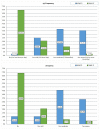Reevaluation of the Acute Cystitis Symptom Score, a Self-Reporting Questionnaire. Part II. Patient-Reported Outcome Assessment
- PMID: 29883423
- PMCID: PMC6022869
- DOI: 10.3390/antibiotics7020043
Reevaluation of the Acute Cystitis Symptom Score, a Self-Reporting Questionnaire. Part II. Patient-Reported Outcome Assessment
Abstract
This study aimed to reevaluate the Acute Cystitis Symptom Score (ACSS). The ACSS is a self-reporting questionnaire for the clinical diagnosis of acute uncomplicated cystitis (AC) and the assessment of symptomatic changes after therapy in female patients with AC. The part II of the present study was to reevaluate the utility of the different domains of the ACSS after therapy. The applicability of these domains in assessing changes in symptoms, as a function of time, in this population was investigated. The ACSS was evaluated in 48 female patients (mean age 31.1 ± 10.6) in the Uzbek and Russian languages, who returned after therapy and filled in part B of the ACSS, which corresponds to part A with the additional “Dynamics” domain. Descriptive statistics were used, where suitable. The reduction of typical symptoms and quality of life assessment between first and follow-up visit correlated significantly with answers in the “Dynamics” domain. Success/Cure and Non-success/Failure could be clearly differentiated by the scores obtained in “Typical” and “Quality of Life” domains. The ACSS has proven to be a useful instrument to clinically diagnose AC in women. It is also a suitable instrument for patient-reported outcome measures, with applicability both in daily practice and clinical studies. Slight modifications in the “Dynamics” domain will even increase the applicability.
Keywords: Acute Cystitis Symptom Score; cystitis; female; patient-reported outcome; quality of life; questionnaire; urinary tract infection.
Conflict of interest statement
The authors declare no conflict of interest.
Figures








Similar articles
-
Reevaluation of the Acute Cystitis Symptom Score, a Self-Reporting Questionnaire. Part I. Development, Diagnosis and Differential Diagnosis.Antibiotics (Basel). 2018 Jan 15;7(1):6. doi: 10.3390/antibiotics7010006. Antibiotics (Basel). 2018. PMID: 30720775 Free PMC article.
-
The Acute Cystitis Symptom Score for Patient-Reported Outcome Assessment.Urol Int. 2016;97(4):402-409. doi: 10.1159/000448591. Epub 2016 Sep 3. Urol Int. 2016. PMID: 27591987
-
Linguistic and Clinical Validation of the Tajik Acute Cystitis Symptom Score for Diagnosis and Patient-Reported Outcome in Acute Uncomplicated Cystitis.Medicina (Kaunas). 2023 Aug 25;59(9):1549. doi: 10.3390/medicina59091549. Medicina (Kaunas). 2023. PMID: 37763668 Free PMC article.
-
[Are there alternatives to antimicrobial therapy and prophylaxis of uncomplicated urinary tract infections?].Urologiia. 2014 Nov-Dec;(6):5-8, 10-3. Urologiia. 2014. PMID: 25799720 Review. Russian.
-
Forensic Use of the Five Domains Model for Assessing Suffering in Cases of Animal Cruelty.Animals (Basel). 2018 Jun 25;8(7):101. doi: 10.3390/ani8070101. Animals (Basel). 2018. PMID: 29941781 Free PMC article. Review.
Cited by
-
Reevaluation of the Acute Cystitis Symptom Score, a Self-Reporting Questionnaire. Part I. Development, Diagnosis and Differential Diagnosis.Antibiotics (Basel). 2018 Jan 15;7(1):6. doi: 10.3390/antibiotics7010006. Antibiotics (Basel). 2018. PMID: 30720775 Free PMC article.
-
Additional assessment of Acute Cystitis Symptom Score questionnaire for patient-reported outcome measure in female patients with acute uncomplicated cystitis: part II.World J Urol. 2020 Aug;38(8):1977-1988. doi: 10.1007/s00345-019-02948-8. Epub 2019 Sep 23. World J Urol. 2020. PMID: 31549179 Free PMC article.
-
Clinical Validation of the Greek Version of the Acute Cystitis Symptom Score (ACSS)-Part II.Antibiotics (Basel). 2021 Oct 15;10(10):1253. doi: 10.3390/antibiotics10101253. Antibiotics (Basel). 2021. PMID: 34680833 Free PMC article.
-
Diagnosis of acute cystitis in primary care: symptom-based versus urinalysis-based diagnosis.Prim Health Care Res Dev. 2022 Nov 17;23:e74. doi: 10.1017/S1463423622000627. Prim Health Care Res Dev. 2022. PMID: 36384980 Free PMC article.
-
Validation of the Spanish Acute Cystitis Symptoms Score (ACSS) in native Spanish-speaking women of Europe and Latin America.Neurourol Urodyn. 2023 Jan;42(1):263-281. doi: 10.1002/nau.25079. Epub 2022 Nov 6. Neurourol Urodyn. 2023. PMID: 36335613 Free PMC article.
References
-
- Wilcoxon F. Individual comparisons by ranking methods. Biom. Bull. 1945;1:80–83. doi: 10.2307/3001968. - DOI
LinkOut - more resources
Full Text Sources
Other Literature Sources

